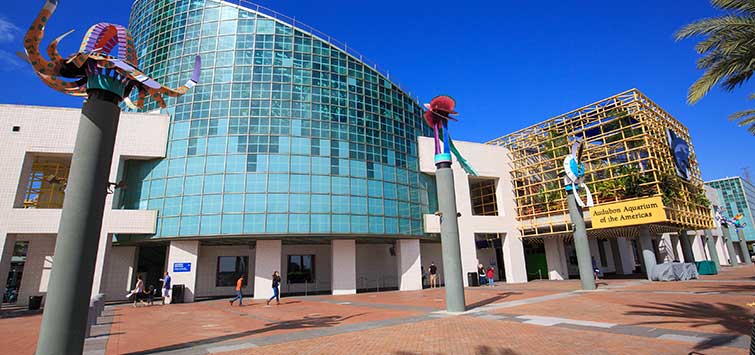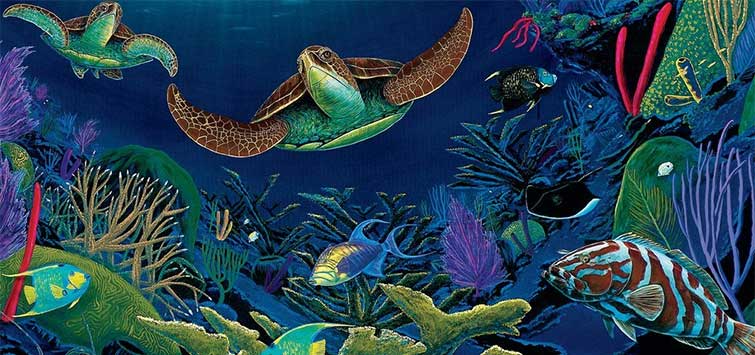The Audobon Aquarium of the Americas
Author: Iggy Tavares
A traveling public aquarium enthusiast visits New Orleans’ Audubon Aquarium, a state-of-the-art facility spotlighting the aquatic life in the Gulf of Mexico and Caribbean, with almost 600 species represented.
Revival
The Audubon Aquarium of the Americas opened in 1990 with an emphasis on showing off aquatic life in the waters around New Orleans as well as the Gulf of Mexico and the Caribbean. My first visit to the aquarium was in 1999, when I also enjoyed a 3-D IMAX film featuring the kelp forests off the California coast.
Unfortunately, Hurricane Katrina struck New Orleans in 2005 and caused devastation to the surrounding areas. Although the aquarium buildings for the most part withstood the hurricane, the life-support system failed, resulting in huge loss of the fish stock. The aquarium reopened in May 2006 and today boasts some 15,000 sea creatures, representing nearly 600 species, all living happily in state-of-the-art facilities. So I was excited recently to be able to make the trip to New Orleans and revisit the Audubon Aquarium.
Great Maya Reef
The journey into the Audubon Aquarium of the Americas today begins with a slow stroll through the new Great Maya Reef exhibit via an acrylic tunnel that is 30 feet (9 meters) long and that penetrates an enormous 132,000-gallon (500,000-liter) tank that is 4200 square feet (390 square meters) in area and 16½ feet (5 meters) deep. Here hundreds of colorful fishes that normally inhabit the Yucatan reefs of Mexico swim around ancient submerged ruins of a Mayan city covered in colorful corals as the backdrop.
Types of Fish
Some of the mid-sized fishes include lookdown fish (Selene vomer), yellowtail snappers (Ocyurus chrysurus), and saucer-eye porgies (Calamus calamus), but there is also a wealth of more familiar fishes, such as various angelfishes, wrasses, and tangs, that one could have in a home aquarium. Cow-nose rays sail by but get very excited during the Reef shows featuring a diver who hand-feeds the fishes several times a day.
On leaving the tunnel, the reef experience is enhanced by nine close-focus exhibits that give visitors a closer look at particular aspects of species enhanced with state-of-the-art digital touch screens. The biggest of these exhibits is the 5500-gallon (21,000-liter) circular schooling tank with false pilchards (Harengula clupeola) that are on an endless swim round their home, while another cylinder features schooling reef fishes and moray eels.
Other Wonderful Displays
Other displays to look out for include the Artificial Reef, where corals and sponges take a foothold on manmade structures such as Mayan stone stairs; it features Caribbean spiny lobsters and colorful fishes. The At Depth exhibit houses deeper-water fishes, and another shows the enigmatic red lionfish (Pterois volitans) that are invading the Caribbean and eating all the smaller residents.
Amazon River Displays
Amazon Rainforest
The Amazon Rainforest exhibit upstairs is set in a forest-like atrium with plenty of trees and includes a walkway towards the treetops. It has several large open-top aquarium enclosures, with a waterfall cascading into one of them.
Big River Big Fish
The Big River Big Fish display is particularly interesting; it holds a couple of medium-sized red-flanked pirarucu (Arapaima gigas) cruising near the water surface while redtail catfish (Phractocephalus hemioliopterus) and orange- spotted stingrays (Potamotrygon motoro) prefer the bottom levels, leaving the middle waters to the pacus (Colossoma sp.).
Shallow Flooded Forest
A nice contrast is the Shallow Flooded Forest, which is given over to Corydoras catfishes and colorful small tetras, along with others that hobbyists might normally keep in their home aquariums.
Amazon River Edge
The Amazon River Edge has a surprisingly large anaconda that for the most part lies motionless following a feeding of a whole rabbit once a month, while silver prochilodus (Semaprochilodus taeniurus) swim untroubled in the water. The piranhas (primarily Serrasalmus sp.) in their display stand still for the most part, occasionally changing their location, but they can work themselves into a frenzy at feeding time. The cichlid display with several redhead cichlids (Paraneetroplus synspilus), which also contained many banded leporinus (Leporinus fasciatus) and one mid-sized tiger shovelnose catfish (Pseudoplatystoma fasciatum), caught my eye, as some of the cichlids had paired up and were showing some pre-spawning behavior.
Parakeet Pointe
Parakeet Pointe near the Amazon area is especially popular, as adults and children have the opportunity to get close and personal with dozens of fairly tame, free-flying, colorful parakeets that are happy to be hand fed.
Penguins
The Penguins exhibit, featuring colonies of South American rockhopper penguins (Eudyptes chrysocome) with their yellow head plumes and African blackfooted penguins (Spheniscus demersus), houses both in a large glass-encased enclosure that offers a rocky habitat and a nice large pool. These penguins both come from a relatively warm temperate climate, which is why they can be accommodated together. Everyone loves to watch ungainly penguins that waddle and hop on land change into sublime movers in water, making this exhibit rather popular.
The aquarium is having good success in breeding penguins, with the hatching of some endangered blackfooted penguin chicks last year. The penguins are fed twice a day with small fishes that include capelin, herring, and trout, while a Backstage Penguin Pass offers visitors a hands-on close encounter.
Living in Water
The Living in Water exhibit has various-sized exhibits that focus on the special attributes or circumstances of their inhabitants and how these animals “make their living” in water, ranging from the symbiotic relationship between clownfishes and anemones to noise-makers, such as grunts, porkfish, and sheepsheads, which grunt, squeak, or even whistle by grinding their teeth, vibrating their swim bladders, or burping out air.
There are nice displays of surface-swimming Anableps, the so-called four-eyed fish that have the capability of seeing above and below the water line, while another houses an electric eel capable of generating a 500-volt electric shock to disable live prey.
Small native Louisiana fishes, such as crappie (Pomoxis annularis), sunfishes, small catfishes, and more, are featured in their own exhibit. A large display of the invasive Rio Grande cichlid (Herichthys cyanoguttatus), which guards its eggs and fry, educates the public on the dangers of releasing foreign aquarium fishes that out-compete native fish populations into extinction. A display of live Indo-Pacific coral with royal blue tangs and bird wrasses is another feature to watch for.
Seahorses Gallery
The Seahorses gallery currently features longsnout seahorses (Hippocampus reidi), lined seahorses (Hippocampus erectus), and potbellied seahorses (Hippocampus abdominalis), the latter two of which are breeding. Male seahorses incubate the female’s eggs in a special pouch after fertilizing them, carrying them there for two to four weeks before releasing the young.
Seahorses appear to glide through the water, which they do by fluttering their dorsal fin 20 to 30 times per second while using their pectoral fins to steer. Their aquariums are planted with sea grasses, to which the seahorses can cling with their tails when they are stationary. The seahorses are fed live shrimp as well as smaller copepods and amphipods.
Frogs—Beyond Green
The Frogs—Beyond Green exhibit features many different types of colorful frogs and even a toad accommodated in brand-new habitats containing orchids, bromeliads, and other exotic plants. This exhibit also features a film show as well as lots of interactive, fun activities. Behind the scenes, Audubon Aquarium has a breeding program that includes more than a dozen dart frogs, such as the blue dart frog (Dendrobates tinctorius), three-striped dart frog (Ameerega trivittata), and even the golden poison dart frog (Phyllobates terribilis).
Some species lay their eggs under a leaf, where the male cares for them until they hatch some two weeks later. The resulting tadpoles are then carried on their backs to be deposited in pools of water and take a further 10 to 12 weeks to develop into froglets.
Playful Otters
A pair of Southern sea otters, a protected species that did not rehabilitate well to the wild in the Californian kelp forests, is housed in a 25,000-gallon (95,000-liter) exhibit with two swimming pools and a large behind-the-scenes area. Sea otters, with their very high metabolism rate, are ravenous eaters, requiring 9 to 12 pounds (4 to 5 kg) of shrimp, crabs, squid, clams, mussels, and fish every day. The always-on-the-go sea otters are a delight to watch as they play with a wide variety of toys during their daily training, which provides both mental and physical exercises that are very popular with the public.
Geaux Fish
Geaux Fish (pronounced “go fish,” a play on the Cajun suffix -eaux) is a new gallery that highlights the Louisiana fishing industry by combining live exhibits with lots of interactive games and stations for kids to explore. Among various small displays, two feature several species of baitfishes, including the main catch of Atlantic menhaden (Brevoortia tyrannus), which is mostly made into meal and fish oil rather than used as bait. Another display with young lookdowns (Selene vomer), bluestriped grunts (Haemulon sciurus), and more is popular, as children can pop their heads into a glass bubble underneath for an extraordinarily close-up view of the fishes.
The Louisiana Fish Tagging program display is the largest in Geaux Fish. It contains some handsome mid-sized specimens of red drum (Sciaenops ocellatus), speckled trout (Cynoscion nebulosus), and sheepshead (Archosargus probatocephalus). Volunteer anglers in Louisiana are encouraged to tag, measure, and release saltwater fishes in the state’s inshore and offshore waters, with some 10,000 tagged in 2013. Whenever a tagged fish is recaptured, length and location information provides details about growth rates and migration patterns.
Geaux Fish also has exhibits that allow guests to cast a virtual reel, identify local species, visit a seafood market, or hop on a fishing boat. The ever-popular Cow-nose Stingray Pool is a must, since one can touch and feed the rays as they slowly swim past in their shallow pool.
Mississippi Gallery
The Mississippi Gallery and its freshwater exhibits offer views of some of the inhabitants of the Mississippi River in several large and small exhibits. One exhibit features several paddlefish (Polyodon spathula), a long-lived primitive species with a spatula-like snout that is used to detect the weak electrical fields of small prey creatures. The filter-feeding paddlefish receive a variety of small shrimp, clams, and flakes broadcast-fed throughout the enclosure several times a day.
Other exhibits house a large blue catfish (Ictalurus furcatus), found primarily in the Mississippi River drainage, and a school of channel catfish (I. punctatus), found in many parts of North America. Both catfish species, which are popular fishing targets, will eat just about anything and are fed with pellets and whole small fishes.
The Rare White Alligator
The highlight of this gallery is the rare white alligator, one of just 18 such animals currently known in the wild. Although they might look like albinos, they are not, being given away by their steely blue eyes rather than the red eyes typical of true albinos. They are classed as leucistic, having a gene mutation that gives them the white skin and blue eyes. Alligators fast during the colder months, but during the summer this alligator is fed as often as once a week with raw chicken, quail, and whole fish.
Gulf of Mexico Exhibit
The Gulf of Mexico Exhibit is 17 feet (5 meters) deep and contains some 400,000 gallons (1,500,000 liters) kitted out with loads of pilings covered in barnacles representing a quarter-scale replica of an offshore oil rig. It is teeming with schools of fishes such as jacks (Caranx lugubris) and blue runners (Caranx crysos), Atlantic spadefish (Chaetodipterus faber), yellowtail snappers (Ocyurus chrysurus), many stingrays, and a green sea turtle.
However, two ferocious-looking, toothy-mouthed sand tiger sharks (Carcharias taurus) grab the attention of visitors as they slowly swim around their exhibit. Surprisingly, these fairly placid sharks take seven years to reach sexual maturity and give birth to just two pups after a two-year gestation, which might explain why they are not doing too well in the wild. Other sharks to look out for are some brown sharks (Carcharhinus plumbeus) and nurse sharks (Ginglymostoma cirratum), both of which are generally mild-mannered bottom-dwellers. The sharks are fed three times a week, typically with large herring, mackerel, or filets of amberjack, cobia, or other large food fishes.
I was rather excited to see so many large, magnificent-looking tarpon (Megalops atlanticus), covered in large and shiny silvery scales, actively swimming in the middle waters of the exhibit. Sometimes the tarpon go up to the water surface to gulp air to fill their swim bladders; from there they are able to extract oxygen in addition to using their gills. This ability allowed the tarpon to survive the Hurricane Katrina disaster in spite of the damaged life-support systems. The tarpon get a daily feeding of cut mackerel, whole capelin, or squid.
Water Quality Maintenance
There were just five life-support systems maintaining water quality in the building when Hurricane Katrina struck in 2005, but today there are over 30 separate life-support systems throughout the Aquarium.
Filters
The Gulf of Mexico exhibit has several sand filters and receives ozone from its bank of ozone generators. The Great Maya Reef tunnel has a sand filter, receives ozone, and in addition uses foam fractionation (protein skimming) to get rid of organic wastes.
Water Changes
Water changes are done in conjunction with weekly backwashing. All of the smaller marine systems have their own independent system. The sea water in the Gulf of Mexico exhibit, the Great Maya Reef tunnel, and other smaller exhibits is made up from an in-house salt recipe. The large freshwater and Amazon and Mississippi galleries also use sand filters for mechanical filtration and ozone to kill bacteria, with weekly backwashes and water changes.
The maintenance on the insides of the exhibits is done by divers in wet suits who rid them of leftover food and debris and clear the viewing windows of algae. In the Gulf of Mexico exhibit containing sharks, four divers work at a time, with two designated as cleaners and the other two carrying a PVC stick to fend off sharks, tarpon, and even the turtle. Divers also clean the Amazon galleries. A diver even enters the piranha gallery weekly—much to the consternation of the public—but is unharmed.
A Fun and Educational Visit
I enjoyed my visit to the Audubon Aquarium of the Americas. It gave me the opportunity to see and learn about the aquatic life in the great Mississippi River and the Gulf of Mexico. I liked their emphasis on conservation that is highlighted in their new Geaux Fish exhibition, and I also learned about all the behind-the-scenes rescue work of stranded animals that they do.
Audubon Aquarium still retains some exhibits from my first visit in 1999 that I was pleased to see again, such as the Amazon Rainforest and the Mississippi and Gulf of Mexico exhibits, all of which have been enhanced by various additions of new animals. The new Great Maya Reef is enchanting and hard to drag oneself away from, while others, from Living in Water to Frogs—Beyond Green, are wonderful to explore.
As several of the exhibits feature chats and feeds and also offer interactive activities to keep both children and adults busy, I had an enjoyable morning at the Audubon Aquarium of the Americas. And of course, while in New Orleans I went jazzin’ every evening, enjoying wonderful live music at several different venues, including Preservation Hall, which all made for a wonderful stay in the “Big Easy.”
Aquarium Address
Audubon Aquarium of the Americas
1 Canal Street
New Orleans, Louisiana 70130
www.auduboninstitute.org/visit/aquarium
See the full article on TFH Digital http://www.tfhdigital.com/tfh/october_2014#pg89

.png?h=595&iar=0&w=2781&hash=5FD5E69473BCC22199FBFA2FB71B6033)



